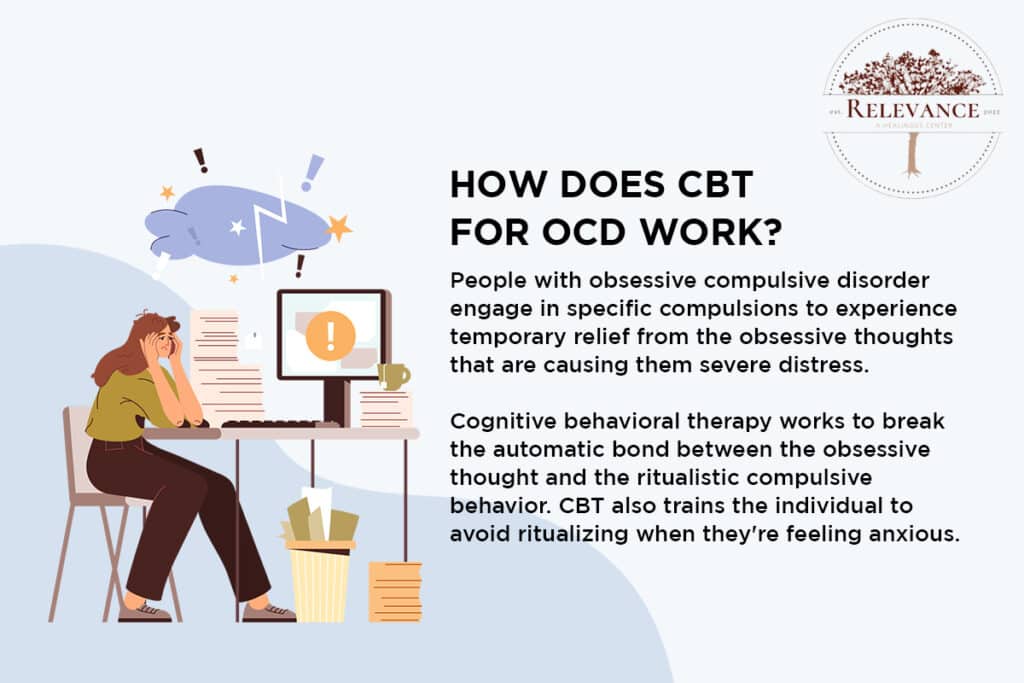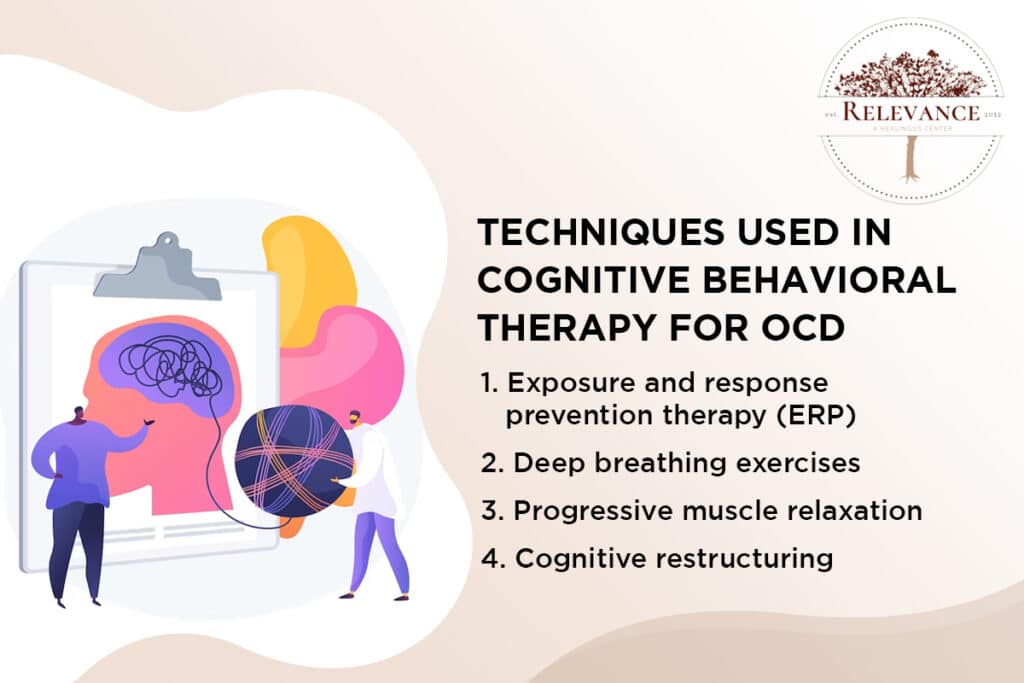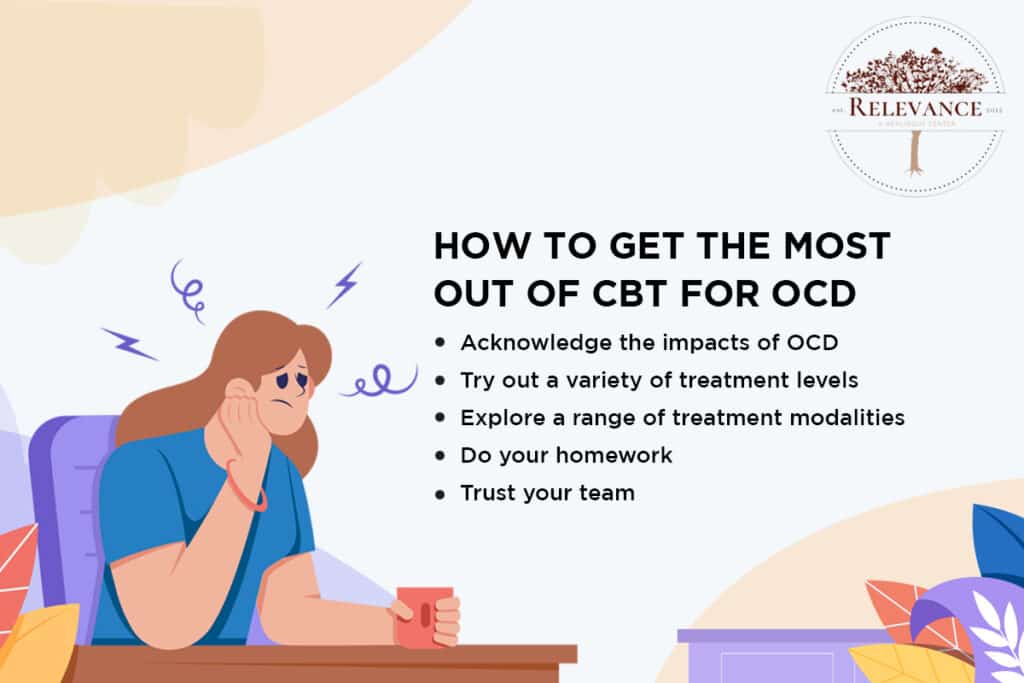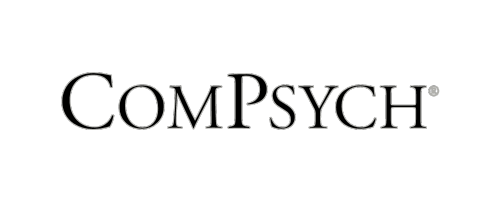Have you been struggling with unwanted thoughts or repetitive behaviors that you can’t seem to shake? If so, you may have obsessive-compulsive disorder or OCD. The good news is there are effective treatments available, like cognitive behavioral therapy or CBT. CBT for OCD works by helping you challenge those obsessive thoughts and break the cycle of compulsive behaviors. With the help of a skilled therapist, Cognitive Behavioral Treatment for OCD can be a game changer.
What Is Cognitive Behavioral Therapy for OCD?
Cognitive behavioral therapy or CBT is a type of psychotherapy focused on changing negative thought patterns and compulsive behaviors. For OCD, CBT involves exposure and response prevention (ERP) therapy where you’re exposed to the thoughts and objects that trigger your obsessions and compulsions but prevented from engaging in the compulsive behavior.
The goals of CBT for OCD are to help you:
- Gain awareness of obsessive thoughts and compulsive urges.
- Develop coping strategies to manage anxiety and resist compulsive behaviors.
- Address the underlying cognitive distortions that fuel the symptoms.
CBT uses several techniques to achieve these goals:
- Exposure therapy exposes you to obsession-triggering thoughts and objects in a controlled setting. This helps desensitize the anxiety and weaken the urge to ritualize.
- Response prevention prevents compulsive behaviors and rituals. You learn to tolerate the anxiety and discomfort without acting on urges.
- Cognitive restructuring helps identify and challenge irrational thoughts. You learn to recognize cognitive distortions like overestimating danger or the need for perfectionism and adopt more balanced ways of thinking.
- Relaxation techniques such as deep breathing, meditation, and mindfulness help lower anxiety levels. The more you practice, the better you get at applying these skills in triggering situations.
With the guidance of a trained CBT therapist, these strategies and tools can be highly effective for managing OCD symptoms. CBT may not cure OCD, but it can significantly reduce distress and impairment, allowing you to live a fulfilling life.
How Does CBT for OCD Work? The Basics
Cognitive behavioral therapy (CBT) for OCD works by helping you challenge negative and obsessive thoughts. The core idea is that thoughts influence behaviors, so changing thoughts can help change behaviors.
How does it work?

CBT teaches you that intrusive, obsessive thoughts are normal and everyone has them. The difference is that for those with OCD, the thoughts trigger anxiety and compulsive behaviors. CBT helps you confront fearful thoughts instead of avoiding them, learning not to react to them.
- Exposure and response prevention (ERP) exposes you to thoughts that trigger anxiety while preventing compulsive behaviors. This helps desensitize you to the thoughts so they no longer cause distress.
- Cognitive restructuring challenges negative and irrational thoughts. Your therapist helps identify thought patterns, evaluate the evidence, and replace those thoughts with more balanced and realistic ones.
- Relaxation techniques like deep breathing and progressive muscle relaxation help lower anxiety and stress levels. Reducing anxiety makes it easier to resist compulsions.
With the practice of these techniques, the cycle of obsessive thoughts and compulsive behaviors can be broken. CBT gives you the skills to better manage symptoms and live life with less distress and impairment. While CBT may not cure OCD, it can be very effective at reducing symptoms and increasing quality of life.
The key is finding a therapist experienced with CBT for OCD and sticking with treatment. CBT is a collaborative process, so being open and willing to try different techniques will help you get the most out of therapy. With hard work and commitment to facing your fears, CBT can be a life-changing treatment for overcoming OCD.
Exposure and Response Prevention Therapy (ERP)
Exposure and Response Prevention Therapy (ERP) is a key technique used in CBT for OCD. ERP involves gradually exposing yourself to the thoughts, images, objects, and situations that trigger your obsessive thoughts and compulsive behaviors. At the same time, you work to prevent the compulsive behaviors you would normally do in response. This helps desensitize you to the triggers and retrain your brain.
Who Will Find Exposure and Response Prevention Therapy Most Helpful?
Exposure and Response Prevention Therapy (ERP) is a powerful technique that forms a fundamental part of Cognitive Behavioral Treatment (CBT) for OCD. By gradually exposing individuals to their triggering thoughts, images, objects, or situations, while simultaneously preventing their usual compulsive behaviors, ERP helps desensitize and retrain the brain.
To get started with ERP, you and your therapist will collaborate to create a hierarchy of triggering situations. This list will rank the situations from least anxiety-provoking to most anxiety-provoking. The goal is to begin with the lower-ranked items and gradually work your way up at a pace that feels comfortable for you. For instance, if you struggle with contamination OCD, your therapist may suggest touching public objects without immediately washing your hands. During this exposure, you will learn to sit with the anxiety and resist the urge to engage in compulsive washing. Over time, through the process of habituation, you will notice a decrease in anxiety levels.
ERP is most beneficial for individuals who are committed to making positive changes. It requires dedication, persistence, and an open mind. By actively participating in ERP, you empower yourself to confront your fears and break free from the cycle of obsessive thoughts and compulsive behaviors. While ERP may not offer a complete cure for OCD, it is highly effective in reducing symptoms and improving overall quality of life.
Cognitive-Behavioral Therapy
It is crucial to find a therapist who specializes in CBT for OCD and to maintain consistency in treatment. Remember that CBT is a collaborative journey, and your willingness to explore different techniques will greatly enhance the benefits of therapy. Facing your fears and embracing the challenges may seem daunting, but with determination and support, CBT can truly be a life-changing treatment for overcoming OCD.
As another example, if you have obsessive thoughts about harming others, you may start by holding a kitchen knife for a brief time. You’ll learn to tolerate the anxiety from the intrusive thoughts without acting on compulsions to reduce that anxiety, like putting the knife down. With practice, the thoughts and urges will cause less distress.
The key is to stay in the situation until your anxiety starts to decrease, even if just slightly. Don’t leave too soon. Start with just a few minutes and build up from there. This teaches your brain that the feared outcome you obsess about likely won’t happen, and you can tolerate the uncertainty. Over time, facing your triggers will get easier as your anxiety continues to decrease during exposures.
ERP can be challenging, but many studies show it’s very effective in reducing OCD symptoms. Committing to facing your fears, with the help and support of a therapist, is the best way to overcome your OCD and live with more freedom. While it may seem impossible, you have the strength and ability to succeed. With practice and patience, you can beat OCD.
Other CBT Techniques: Deep Breathing, Muscle Relaxation, and Cognitive Restructuring
Other effective CBT techniques for OCD include deep breathing, progressive muscle relaxation, and cognitive restructuring. These can help lower anxiety and stress levels, allowing you to face fearful thoughts and resist compulsive urges.

- Deep breathing exercises teach you to slow your breathing and focus your attention. Take deep, controlled breaths from your diaphragm to trigger your body’s natural relaxation response. Start by finding a quiet, distraction-free place. Sit comfortably, close your eyes, and place one hand on your chest and one on your stomach. Breathe in slowly through your nose so your stomach pushes your hand out. Breathe out through pursed lips while feeling your stomach fall. Repeat for 5 to 10 minutes a day.
- Progressive muscle relaxation involves systematically tensing and relaxing different muscle groups in your body one by one. Start with your toes and feet, then ankles, calves, knees, thighs, hips, abdomen, chest, shoulders, arms, and face. Tense each area for 5 seconds, then release and relax for 10 to 15 seconds. Notice the difference between tension and relaxation. This helps reduce anxiety and stress.
- Cognitive restructuring, also known as cognitive therapy (CT), focuses on challenging and changing the problematic thoughts, beliefs, and cognitive biases that contribute to OCD symptoms. A therapist will help you identify negative automatic thoughts, evaluate the evidence for and against them, and replace them with more balanced and realistic thoughts. This can help reduce obsessive thoughts and compulsive urges over time.
Using a combination of these techniques, along with exposure and response prevention therapy (ERP), can be very effective for treating OCD. Practice them regularly and be patient through the process. Over time, facing your fears and resisting compulsions will become easier as your anxiety and stress levels decrease. With continued practice of ERP and CBT strategies, you can overcome OCD.
Is CBT an Effective Treatment for OCD? The Research Says…
So, does CBT actually work for OCD? The short answer is yes, numerous research studies have shown CBT to be an extremely effective treatment for OCD. In fact, CBT is considered the gold standard of treatment for OCD.
Effective for Many Patients
Studies show that about 50-70% of OCD patients who complete a full course of CBT experience significant symptom reduction or remission. For some patients, CBT alone can effectively treat their OCD. For others, CBT works best when combined with medication. CBT also helps prevent relapse, and its effects can last for years after treatment ends.
As Effective as Medication
CBT has been shown to be as effective as medication for many OCD patients. Some studies even show CBT to be slightly more effective in the long run. CBT also avoids the potential side effects and dependence that can come with medication. For these reasons, CBT is often tried first before medication or used in combination with drugs.
Changes the Brain
Interestingly, CBT for OCD has been shown to physically change the brain. Studies using fMRI scans show that CBT can alter activity in the prefrontal cortex, basal ganglia, and other parts of the brain involved in OCD. CBT also leads to changes in neurotransmitters like serotonin that are related to mood and anxiety. These physical changes in the brain are thought to underlie the long-lasting effects of CBT.
A Lifesaver for Some
For certain OCD patients, especially those with severe symptoms, CBT can be lifesaving. CBT gives people the skills and strategies to break free from obsessive thoughts and compulsive behaviors, allowing them to live happy and fulfilling lives. While CBT requires hard work and dedication, for many it is worth the effort.
In summary, decades of research and clinical experience clearly show CBT to be an incredibly effective treatment for OCD. If you or someone you love is suffering from OCD, CBT could truly be a transformative option.
Finding a Qualified CBT Therapist for OCD Treatment
Finding a qualified cognitive behavioral therapist is key to effective treatment for OCD. Look for therapists with experience specifically treating OCD and anxiety disorders using CBT techniques like Exposure and Response Prevention Therapy (ERP).
Ask potential therapists about their experience helping clients with OCD. An experienced CBT therapist should be able to explain how techniques like ERP work to challenge unhealthy thoughts and behaviors. They should take the time to understand your specific obsessions and compulsions to develop a customized treatment plan.
You’ll also want to consider the therapist’s credentials and qualifications. Many CBT therapists are licensed clinical psychologists, social workers, or professional counselors. Some hold certifications in CBT like the Certified Cognitive Therapist (CCT) certification. While credentials aren’t everything, they demonstrate the therapist’s commitment to CBT training and practice.
Meet with a few therapists for a consultation to find one you feel comfortable with. Consider things like their communication style, availability for appointments, cost, and how willing they seem to be to involve family members in your treatment if needed. You should feel heard, supported, and optimistic after meeting with a potential CBT therapist. If not, keep looking.
Sticking with CBT treatment can be challenging, so find a therapist you connect well with and who motivates you. Ask about their success rates treating OCD, and look for reviews from other OCD clients if possible. A good CBT therapist will encourage and support you through the difficult periods of treatment. They should push you outside your comfort zone in a gentle, compassionate way as you work to overcome obsessions and compulsions.
With the right CBT therapist by your side, you can overcome OCD. Be picky and don’t settle until you find a therapist you trust to guide you through effective treatment and recovery. The effort to find the best CBT therapist for you will be well worth it.
Maximizing Your CBT Sessions: How to Get the Most Out of Therapy
To get the most out of your CBT sessions for OCD, there are a few key things you can do.

Be an active participant.
Don’t just show up for your appointments. Do the homework assignments, practice the strategies, and ask questions. CBT is a collaborative process between you and your therapist, so speak up about what is and isn’t working. The more you put into it, the more you’ll get out of it.
Focus on one issue at a time.
Don’t feel overwhelmed by trying to tackle all of your OCD symptoms at once. Work with your therapist to identify specific behaviors or thought patterns to focus on, one by one. As you make progress, you can move on to other issues. But take it step by step.
Practice the exposure techniques.
Exposure and response prevention (ERP) is a key part of CBT for OCD. It involves gradually exposing yourself to the thoughts, objects, and situations that trigger your obsessions and compulsions while resisting the urge to engage in rituals. These exercises can be challenging but are very effective. Stick with them and be patient through the anxiety and discomfort. It will get easier over time.
Challenge negative thoughts.
Notice the negative and irrational thoughts that worsen your anxiety and fuel compulsive behaviors. Work to challenge these thoughts and replace them with more balanced and realistic ones. This cognitive restructuring is an important skill that can help reduce OCD symptoms.
Use relaxation techniques.
Practice deep breathing, meditation, yoga, or progressive muscle relaxation. Reducing overall anxiety and stress will help you better manage your OCD symptoms. These techniques can also help you stay calm during ERP exercises.
Communicate openly.
Talk to your therapist about any roadblocks, setbacks, or difficulties you’re experiencing. Be honest about what is and isn’t helping so you can make adjustments to your treatment plan. CBT for OCD works, but it may take some trial and error to find what works best for you. Open communication will help get you there.
With hard work and persistence, CBT can be very effective at relieving OCD symptoms. Follow these tips to maximize your success with therapy. Stay committed and keep an open mind. You’ve got this!
At-Home Exercises and Tools to Enhance CBT for OCD
At-home exercises and tools can enhance your CBT for OCD treatment and help you better manage your symptoms between sessions. Some techniques you can practice yourself include:
Exposure exercises
With guidance from your therapist, try gradual exposure to triggers that cause obsessive thoughts or compulsive behaviors. Start with something minor and slowly work your way up to more challenging exposures. This helps desensitize you to the triggers and retrain your brain. For example, if contamination fears trigger your OCD, start by briefly touching a “dirty” surface without washing your hands, then work up to not washing for longer periods.
Thought challenging
Notice obsessive thoughts as they arise and try to challenge them with more balanced thoughts. Ask yourself questions like: “What evidence do I have that the thought is true?” “What are alternative ways of viewing the situation?” Writing down both the obsessive and balanced thoughts can help give them more perspective. With regular practice, balanced thoughts can become more automatic.
Relaxation techniques
Practice deep breathing, meditation, yoga, or progressive muscle relaxation. Reducing overall anxiety and stress can help decrease OCD symptoms. Take 10-15 minutes a day to sit quietly, breathe slowly and deeply, and release any tension in your body.
Keep a symptom journal
Record your obsessive thoughts, compulsive urges, and behaviors, and how you responded to them. Look for patterns and situations that trigger your OCD. Share this journal with your therapist, who can then help customize your treatment plan and provide guidance for managing specific situations. The simple act of recording symptoms can also help you gain awareness and feel more in control.
Using these tools in combination with CBT therapy sessions will give you the best chance at effectively managing your OCD. Be patient through the process, as facing your triggers and challenging long-held thought patterns can be difficult. But with regular practice of these exercises, your symptoms can improve over time. Talk to your therapist if you have any concerns or want more suggestions for at-home strategies. Together, you can find what works best for you.
Common Questions asked about CBT for OCD
CBT for OCD involves some common questions that are important to address:
Will CBT cure my OCD?
CBT can be very effective in managing OCD symptoms, but there is currently no “cure” for OCD. However, many people experience significant improvement with CBT and can gain more control over their obsessions and compulsions. CBT teaches you strategies to better manage your OCD, though it may require ongoing practice and maintenance.
How long will CBT take to work?
The duration of CBT treatment varies from person to person. Typically, CBT for OCD involves weekly sessions over 12-20 weeks. Some people start to feel better in just a few weeks, while for others it can take 3 months or longer of continuous practice to experience significant improvement. The key is sticking with the treatment and techniques.
Will my medication interfere with CBT?
Medications for OCD are frequently employed in conjunction with CBT. Additionally, CBT may yield even more favorable results when coupled with medication. Furthermore, the essential point to consider is that any medications you’re currently taking should be geared towards diminishing OCD symptoms sufficiently, thereby enabling you to actively participate in the CBT techniques.You should talk to your doctor about any medication adjustments that may help improve your CBT outcomes.
What if CBT doesn’t work for me?
If after giving CBT a fair trial of at least 3-4 months you don’t experience meaningful improvement in your OCD symptoms, there are some options:
- Try a different CBT therapist or program. Different therapists have different styles and some may be a better fit.
- Consider intensive outpatient or inpatient treatment. More intensive programs may be needed for severe or treatment-resistant OCD.
- Explore other therapies like mindfulness-based therapies, habit reversal training, or acceptance and commitment therapy.
- Discuss medication changes or alternatives with your doctor. Sometimes a medication switch or augmentation can help.
- Don’t lose hope. Keep trying– it can take time to find what works best for you. New treatments for OCD are always being studied, so more options may become available.
The most important thing is not to give up. Keep working with your mental health professionals to determine what treatment plan is most effective for gaining control of your OCD.
Conclusion
So there you have it – cognitive behavioral therapy can be an incredibly effective treatment for OCD. While facing your fears and breaking unhealthy thought patterns certainly isn’t easy, the rewards of overcoming OCD and gaining freedom from obsessive thoughts and compulsive behaviors can be life-changing. If you commit to the process, do the work, and stick with it, CBT offers real hope and healing. You owe it to yourself to take that first step – find a CBT therapist who’ll help you manage OCD, start practicing your exercises, and begin the journey towards an OCD-free life. You’ve got this! Stay strong and keep fighting the good fight. There are brighter days ahead, and CBT can help you get there.



















